Phono Preamps/Moving-Coil Step-up Devices
Class A+
Class A
Class B
Class C
Class D
Class A+
 |
Boulder 2008: $38,000 ✩ Despite everything else he had ever heard or reviewed, MF could never have been prepared for what the 2008 offered. He was taken to a higher level: "What the 2008 delivered was the music's meaning....It was like analog on acid. Every note, every musical gesture became the most important, most profound note ever struck—until the next one....The 2008 gripped, mesmerized, suspended time, and communicated profoundly." The sound, MF raved on, was "faultless in every area of performance: soundstaging, imaging, dynamics, harmonics, frequency extension, solidity, 'bloom'—you name it." MF had no complaints: "As with the Continuum Caliburn turntable, the 2008 belongs in Class A+—the single most impressive electronic audio component I've heard." Compared with the one-third-the-price 1008, the 2008 did sacrifice a little of the 1008's midrange richness for better bass control and greater top-end extension, said MF. (Vol.25 No.7, Vol.33 No.7 Read Review Online) |
 |
Vitus Audio MP-P201 Masterpiece: $60,000 The massive, two-box MP-P201 Masterpiece Series Phono Preamp includes switchable, independently configurable balanced and single-ended inputs and a single balanced output. Available are a choice of four dealer-installed modules for resistive loading, each including 16 different resistances. The MP-P201's dynamic presentation was "nothing short of ridiculous"; its bass extension, control, and weight were "granitic"; speed, transparency, three-dimensionality, frequency extension, rhythmic ability, and musical grip were unsurpassed. "You need to hear it," gushed MF. JA's measurements revealed excellent channel matching and almost zero RIAA error, but nothing to indicate why Mikey was so taken by the Vitus's sound. (Vol.33 Nos.7 & 9 Read Review Online) |
 |
Ypsilon VPS-100: $26,000 ✩ Made in Greece, the moving-magnet VPS-100 is beautifully built and housed in a substantial aluminum case. Joining the Boulder in Class A+, it uses a 6CA4 rectifier tube and choke filter, while RIAA is accomplished passively with zero feedback using a transformer-based LCR network. All internal wiring is done by hand, point to point. While it couldn't quite match the bottom-octave punch, definition, and extension of the Pass Labs XP-25, the Ypsilon produced a more transparent, silky, airy overall sound, said MF. "It produced an absolutely intoxicating blend of stupefyingly extended high frequencies, resolution, clarity, and transient precision, along with tight, deep, nimble, nonmechanical bass, and an ideally rich midrange," said MF and has since purchased the review sample. (Vol.32 No.8, Vol.34 No.3) |
 |
Abbingdon Music Research PH-77 Reference: $11,995 The AMR PH-77 Reference Phono Class Equaliser is a true dual-mono design with unprecedented, microprocessor-controlled features and seemingly limitless flexibility, including 22 phono-equalization curves in addition to RIAA, eight gain settings, and 32 loading options each for MM and MC cartridges. Also included is a 24-bit/96kHz A/D converter, accessible via a rear-panel USB port. Though it lacked the dynamic expression of the Boulder 1008, the PH-77 was "a sweet, tonally well-balanced, quiet performer that produced a large, authoritative sonic picture packed with honest detail," said MF. Though in most ways the PH-77 was a solid performer on the test bench, JA would like to have seen a greater high-frequency overload margin for its moving-coil modes. (Vol.33 Nos.7 & 11 Read Review Online) |
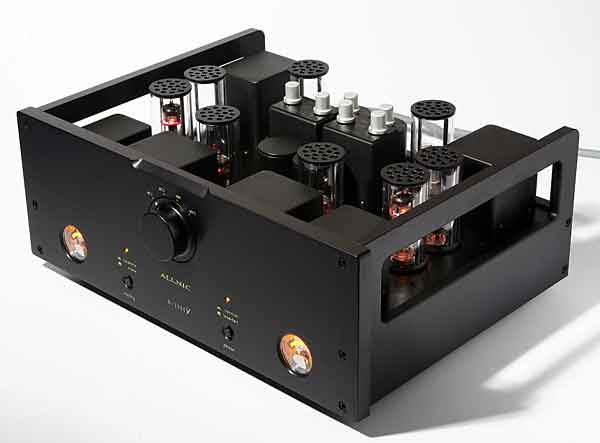 |
Allnic Audio H-3000V: $13,900 This gorgeous, two-box design from Korea features rectification by 5AR4 tubes, and uses two pairs of NOS E810F pentode tubes for the gain stages, plus pairs of 7233 and 6485 voltage-regulator tubes, for a total of eight tubes in the main chassis. Unusually versatile, the H-3000V provides two sets of moving-magnet and moving-coil inputs, a front-panel polarity switch, several gain options, and a wide variety of pre-RIAA curves. The fully balanced, class-A circuit uses no negative feedback. The H-3000V excelled at textural production and musical flow, but lacked definition, transparency, and transient refinement, producing a slightly soft, loose overall sound, said MF. (Vol.34 No.3) |
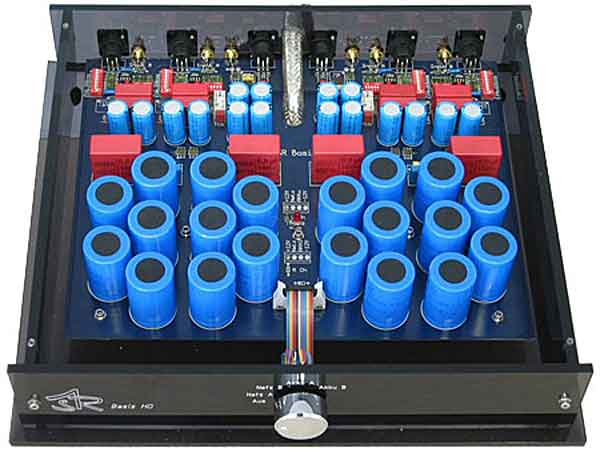 |
ASR Basis Exclusive 2X: $9100 ✩ The battery-powered Exclusive is made of two complete, fully balanced stereo phono preamplifiers on a single chassis, entirely independent except for a shared, switchable output—a major convenience for audiophiles with more than one turntable or with two tonearms mounted on a single "table. The amplifier section is housed in an acrylic chassis, while the power supply is housed in a steel chassis with an acrylic faceplate. MF listed the original Exclusive's strong suits: "rhythmic snap; among the deepest, cleanest, most dynamic bass; and midrange and high-frequency transparency and clarity without etch, grain, or brightness." Revised 2007 edition operates at slightly higher voltages, and remains one of the top phono preamps in Mikey's experience. The 2010 edition offered outstanding transparency, speed, rhythmic snap, and wide dynamics, but lacked midrange warmth, said MF. Multiple gain choices and loading options make the Basis Exclusive 2010 one of the most adjustable phono preamps available, but at this price point it faces stiff competition in terms of sound quality. (Vol.26 No.10, Vol.30 No.2, Vol.34 No.11 Read Review Online) |
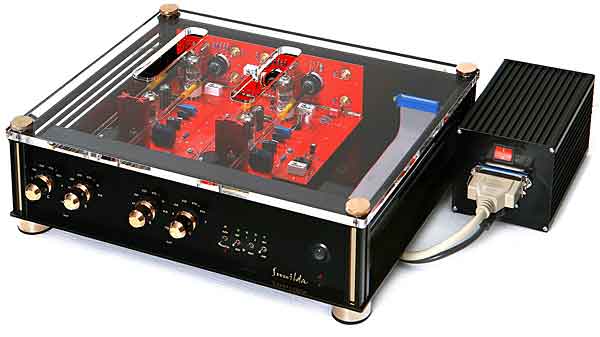 |
AudioValve Sunilda: $5199 The tubed Sunilda offers two independently configurable single-ended inputs selectable for MM or MC and adjustable for resistive and capacitive loading. The dual-mono circuit uses pairs of 6922 and 12AX7 tubes in a three-stage configuration; high-quality parts are used throughout and signal paths are kept short, all but eliminating any point-to-point wiring. The Sunilda sacrificed bass extension and slam for "well-saturated harmonic colors and three-dimensionality," said MF. "The AudioValve Sunilda is one of the most enjoyably balanced tube-based phono preamps I've heard." (Vol.32 No.12) |
 |
Auditorium 23 Hommage T1: $4995 ✩ Over twice the size and weight of the less expensive Standard transformer, the Hommage T1, designed as a companion to Auditorium 23's Solovox loudspeaker, is a statement product. It has a textured-paint finish, attractive white-oak endcaps, and input and output resistances of 3 and 2530 ohms, respectively. The Hommage T1 shared the Standard's excellent timing, flow, and overall drama, but produced a much larger soundstage; and while the Audio Note AN-S8 was slightly richer, the Hommage T1 proved more exciting, said AD. Pairing the Hommage T1 with an EMT OFD 25 mono pickup head resulted in unsurpassed musical and emotional impact, he noted. The Hommage T1 provided more timbral color, more shimmer, and a larger overall sound than did Bob Sattin's CineMag 3440A device, found AD. (Vol.30 No.10, Vol.32 No.8, Vol.33 No.6 Read Review Online) |
 |
Boulder Amplifiers 1008: $13,000 The impeccably built 1008 is a fully balanced, dual-mono design with XLR inputs and outputs. In addition to RIAA, the 1008 includes the Decca, Columbia, and EMI curves for LPs released before 1954, and DIP switches mounted on the Boulder's personality cards select between MM and MC cartridges. It had a slightly soft overall sound, with a bloomy midrange and a forgiving top end, but was capable of producing massive dynamic swings, said MF. "Superb measured performance" and "a standard of construction that is to die for," praised JA. (Vol.33 No.7 Read Review Online) |
 |
Channel D Seta Model L: $3799 Designed to take full advantage of Pure Vinyl's digital RIAA correction, the beautifully built Seta Model L includes balanced and single-ended inputs, balanced unequalized outputs, variable gain, and a built-in, rechargeable battery power supply. Recordings made using the Seta Model L's optional RIAA-equalized outputs were "models of clarity, definition, tonal accuracy, detail resolution, and spatial coherence," said MF. "There is no doubt that the Seta Model L has been superbly engineered," praised JA. Internal RIAA compensation module adds $999. (Vol.33 No.8 Read Review Online) |
 |
EAR 324: $6095 ✩ "A serious and downright scary assault on the state of the art of phono amplification," the solid-state EAR 324 features both MC and MM inputs, with switchable input impedances. While the 324 offers many choices of inputs and settings with provisions for accommodating many different phono cartridges, it had no outstanding sonic signature of its own. AD found the EAR's overall performance to be tight and rhythmically correct without sounding mechanical. Its presentation was "organic, as distinct from artificial," with "a consistently, pleasingly great sense of flow and ease on LP after LP." However, JA found that the EAR's circuit had virtually no headroom in the low bass. The 324 emphasized the leading edges of transients for excellent clarity and coherence without brightness or edge, said Mikey. "As a reliable reference, an all-around quiet and neutral performer, and an "I'm done" product, the EAR 324 is still easy to recommend," he concluded. (Vol.27 No.7, Vol.34 No.9 Read Review Online) |
 |
Esoteric E-03: $5500 The rugged, beautifully made E-03 has two sets of single-ended, chassis-mounted RCA inputs for use with moving-coil or moving-magnet cartridges. Two front-panel input knobs provide options for resistive/capacitive loading and offer a DeMag setting for demagnetizing MC cartridges and outboard step-up transformers. Inside, the E-03's "dual split design" keeps magnetic leakage from contaminating the signal path. Though its midrange lacked some body and color, the E-03 combined airy highs, supple and well-controlled lows, pristine transients, and solid images for an overall sound that was "compelling and unforgettable," said MF. However, he cautioned: "Its wideband, uncolored honesty may not appeal to some." (Vol.33 No.12) |
 |
Haniwa Audio System HEQA01: $5000 The nicely made HEQA01 has moving-magnet and moving-coil inputs and a built-in degausser. It uses electromagnetic damping to permit cartridge tracking as low as 0.6–1.0gm. When used with Haniwa's HCTR01 MC cartridge, the HEQA01 produced a fast, clean sound with exceptional transparency, spaciousness, and three-dimensionality, but lacked some midrange warmth, said MF. Sold direct from Kubotek USA with a money-back guarantee. (Vol.34 No.11) |
 |
Lamm LP2 Deluxe: $7790 ✩ A "super-quiet" dual-mono vacuum-tube phono stage featuring switchable moving-magnet and moving-coil inputs. MF: "Bass extension, control, and definition were startlingly good....Subtle dynamic scaling was on a par with the Boulder and notably superior to the Connoisseur....Subtle string textures, reeds, and female voices were positively thrilling, and the size and weight of the entire picture...was particularly impressive. Add that to snap-you-back-in-your-seat dynamics and authoritative decay, and the Lamm became one of a handful of the finest phono sections I've ever heard." Compared to the phono section of AD's Shindo Masseto, the Lamm LP2 Deluxe had a "more neutral" sound, "with instrumental and vocal timbres sounding clean and right —yet not mechanical or overly dry." (Vol.25 No.12, Vol.32 No.9 Read Review Online) |
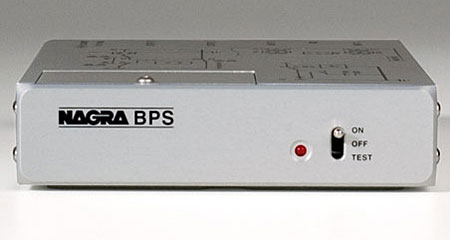 |
Nagra BPS: $2175 ✩ The tiny, lightweight, battery-powered BPS is loosely based on Nagra's more expensive VPS, but uses bipolar transistors instead of tubes. It provides 51dB gain in MM mode and 62dB in MC. With its "upfront transient speed, clarity, and focus," the BPS was "a more neutral, accurate phono preamp than the lush, romantic VPS," said Mikey. Overall, the BPS sacrificed sustain and richness for attack and rhythm. Compared to the Audio Research PH7, the BPS was "lean, fast, tight, and clean," lacking delicacy and harmonic complexity. MF: "If your system needs an injection of excitement, the BPS is guaranteed to do just that." While the BPS sounded good plugged into the AC, it sounded better when powered by its own 9V battery, added FK, who bought the review sample. (Vol.32 Nos.6, 8, & 10 Read Review Online) |
 |
Parasound Halo JC 3: $2350 $$$ The Halo JC 3 is a true dual-mono design with a large R-core transformer power supply. Construction quality is first rate, top-shelf parts are used throughout, and the stout, heavy chassis is beautifully finished. In the JC 3, designer John Curl favored purity over adjustability, offering minimal loading options: 100 ohms or 47k ohms for moving-coil cartridges and 47k ohms for moving-magnet cartridges. Its fully direct-coupled RIAA equalization circuit is based on the circuit used in Curl's famed Vendetta Research SCP-2, while the JC 3's output stage is a true dual-differential, balanced design. In addition, the JC 3 has a built-in AC line conditioner, and its power supplies are modeled after those found in the extremely quiet JC 2 line stage. Though it lacked the dynamics and transparency of either the Pass Labs XP-25 or Ypsilon VPS-100, the JC 3 combined superb musical grip and control with a timbrally and texturally ideal midrange. "The JC 3 represents the best current value in a phono preamp that I know of," said MF. Though it lacked the Sutherland 20/20's tonal richness and punchy sense of pace and drive, the Halo JC 3 produced a detail-rich sound with tight, extended lows, a clean midrange, and carefully drawn images on a huge, open soundstage. "If your tastes run to purity, clarity, neutrality, and detail, you’ll be hard-pressed to find a better phono stage for anywhere near $2350," BD concluded, recommending a Class A rating. The JC 3 sounded remarkably similar to BJR's reference, the Vendetta SCP-2, but lacked some high-frequency purity and ambience recovery. JA noted superb measured performance. (Vol.34 Nos.3 & 10; Vol.35 No.2 Read Review Online) |
 |
Pass Labs XP-25: $10,600 This two-chassis, moving-coil/moving-magnet design offers two inputs and has front-panel controls for several options of gain, capacitive loading, and resistive loading. It uses Pass's XP-20 power supply, which comprises low-noise transformers, RC filtering, and capacitive multipliers. The XP-25's first gain stage uses low-noise transistors and a controlled open-loop gain, while its circuit employs new low-noise, thin-film, surface-mount resistors. The XP-25 produced deep bass, explosive dynamics, and good three-dimensionality, but lacked the Ypsilon VPS-100's top-end air, transparency, and transient speed, said MF. (Vol.34 No.3) |
 |
Simaudio Moon Evolution 810LP: $12,000 The first phono preamp in Simaudio's Moon Evolution line of cost-no-object designs, the fully balanced, dual-mono 810LP is a beautifully built, rigid component weighing 40 lbs and measuring 18.75" W by 4" H by 16.81" D. Its four-layer circuit board uses a five-point, gel-based, floating suspension system derived from the Moon Evolution 850P preamplifier, while the power supply features a high-quality toroidal transformer and multiple filtering and voltage-regulation stages. DIP switches on the bottom panel provide unprecedented configurability: 64 impedance loads, from 12.1 ohms to 47k ohms; 16 capacitance settings, from 0 to 1120pF; 16 gain settings, from 40 to 70dB; and RIAA or IEC equalization. The 810LP had a cool, dry overall sound with exceptional transparency, clean transients, muscular macrodynamics, and delicate microdynamics, but lacked harmonic richness, soundstage size, and top-end air, said MF. (Vol.35 No.12) |
 |
Sutherland Engineering Phono Block: $10,000/pair The Phono Block is a stripped-down, optimized, no-compromise design made of two completely separate but identical monophonic units. Each Phono Block itself comprises two heavily shielded, individual subchassis, one for the power supply and one for the audio stage, linked by the front and rear panels. The Phono Block offers one pair of inputs, two parallel pairs of outputs, a choice of three grounding schemes, and a built-in white-noise generator. Plug-in cards allow the user to select loading and gain. Like Sutherland's battery-powered designs, the Phono Block had an uncanny ease and purity but a more realistic and energetic sense of timing and pace, and created a larger, more enveloping soundstage, said BD. JA noted superb measured performance. (Vol.35 No.1 Read Review Online) |
 |
Sutherland Engineering 20/20: $2200 The single-chassis, solid-state, dual-mono 20/20 shares a family resemblance with Sutherland's earlier models, the PhD and Direct Line Stage, but with slimmer, more graceful proportions. Circuit-board jumpers are used to set gain and loading, and the circuit boards themselves are lavishly executed, with top-quality components employed throughout. Unlike earlier Sutherland designs, which employed a bank of D cells for battery power, the 20/20 uses two inexpensive, outboard power supplies mated to several stages of low-pass RC filtering. The 20/20 combined the power, control, and vivid tonal colors of the Direct Line Stage with the transparency, resolution, and detail of the PhD. "It's simple and easy to use, gorgeous to behold, beautifully built, and an absolutely superb sonic performer," raved BD. (Vol.34 No.2 Read Review Online) |
 |
Ypsilon MC10 & MC16: $2800 ✩ The MC10 transformer produces 20dB of gain and is intended for use with cartridges having an output range of 0.4–0.6mV. Its custom double-coil transformers are shielded with mu-metal and potted in 10mm-thick enclosures coated with soft iron-nickel. Though it lacked the 'shimmering clarity" of the TruLife Audio Reikon, the Ypsilon MC10 produced an "exceptionally expansive and deep" soundstage with solid, dimensional, life-size images, said MF. The MC16 step-up transformer sounds identical to Ypsilon's MC10 but adds 4dB of gain. Compared to the Music First step-up trannie, the MC16 sounded more open, transparent, extended, and three-dimensional, said MF. (Vol.32 No.8, Vol.35 No.6) |
 |
Zesto Audio Andros PS1: $4300 Made in the US, the Zesto Andros PS1 is a dual-mono tubed phono preamplifier with built-in step-up transformer and eight loading options. Its curvaceous, retro-modern exterior doesn’t allow for front-panel controls, but the rear panel is clean, spacious, and logical. Separate moving-magnet and moving-coil inputs permit the simultaneous connection of two tonearms. The Zesto had an addictive, warm overall sound, with plenty of detail, impact, and grace, said MF. "It's among the more enjoyable and satisfying phono preamplifiers I've auditioned at any price," he concluded. (Vol.36 No.3) |
 |
Auditorium 23 Standard: $995 $$$ ✩ Designed and voiced for use with Denon's DL-103, the Auditorium 23 Standard uses two sealed trannies in a nondescript aluminum case, and offers input and output resistances of 7.8 and 505 ohms, respectively. With Denon, Zu, EMT, and Benz cartridges, the sound was "dramatic without being brash, and consistently full-bodied and colorful," said AD. The Auditorium was "slightly coarser" than the Audio Note AN-S8, lacking some sweetness and color, but "a bargain" nevertheless, AD sums up. (Vol.30 No.10 Read Review Online) |
 |
Bob's Devices CineMag 1131: $1195 Designed and made by Bob Sattin in North Carolina, the original CineMag step-up transformer is built into a rugged little cast-alloy box, with a toggle switch for gain selection and another for grounding. It uses a pair of CineMag 3440 transformers, switchable between low- and high-gain settings. Build quality was excellent, with all electrical joints made using an American Beauty resistive soldering station. Compared to the built-in step-up in AD's Shindo Masseto preamplifier, the CineMag was more colorful and punchy, with better timbral distinctions between instruments, approaching the performance of the much more expensive Auditorium 23 Hommage T1. "Nothing less than wonderful," Art said. CineMag 1131 phono transformer is switchable between high and moderately low gains (turns ratios of 1:40 and 1:20, respectively), and features gold-plated connectors, and a ground-lift switch. Compared to the internal Lundahl transformers in AD's Shindo preamplifier, the CineMag 1131 offered greater impact, immediacy, and emotional intensity; compared to the Silvercore One-to-Ten transformer, the CineMag sounded "just as dynamic and punchy, but was also a little bit richer and far, far bigger," he said. The 1131 is borderline Class A. (Vol.33 No.6, Vol.35 No.5 Read Review Online) |
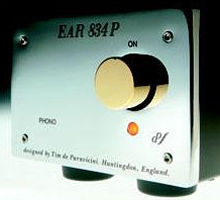 |
EAR 834P: $1895 economy model; $2595 deluxe model ✩ Tim de Paravicini–designed, three-tube (12AX7) MM stage that also offers, for MC use, a pair of step-up transformers (3–50 ohms). MF: "The 834's sound was absolutely gorgeous in the midband, with a touch of 'golden glow,' and an overall spaciousness and enticing musical wholeness....The 834P's bottom-end delivery was well-extended though a bit loose, if only slightly so....[Its] high-frequency extension and transient performance perfectly balanced its bottom: not sharp and etched...but not soft or overly romantic....A slightly sharp, fast-sounding cartridge should really get this thing singing." Compared to the GSP Audio Era Gold Mk.V, BJR found that the EAR 834P exhibited more detail, air, delicacy, and body in the midrange, with more detailed and extended highs, but with rounder, slower bass performance. ST is a long-time owner of the 834 and loves it. Add $700 for chrome Deluxe version. (Vol.20 No.7, Vol.26 No.8, Vol.28 No.1 Read Review Online) |
 |
Graham Slee Reflex M: $1240 Like Graham Slee's previous designs, the lightweight Reflex M is housed in a small aluminum case and is powered by an outboard 24V DC power supply. RIAA equalization is applied actively with the negative feedback loop. There are no loading options. Compared to the Graham Slee Era Gold Mk.V, the Reflex M offered superior image solidity, transparency, and top-end extension, said MF. (Vol.35 No.6) |
 |
Leben RS-30EQ: $2695 Designed to match Leben's CS300 integrated amp, the robustly built CS-30EQ has a decidedly old-fashioned look, with wood side panels and a gold-toned faceplate. It incorporates a pair of common dual-triode tubes for phono gain, but uses a CR-type equalization circuit rather than the more traditional negative-feedback type. A specially made "orient-core" power transformer is employed to minimize hum and noise. Combined with the CS300, the CS-30EQ delivered a rich, punchy, nuanced sound, said AD, who feels it a high value. "A pleasure to look at, a pleasure to use, and delightful to hear," he concluded. JA was bothered by the CS-30EQ's very high output impedance, however, which restricts the CS-30EQ's compatibility with preamps. (Vol.34 No.11 Read Review Online) |
 |
Lejonklou Slipsik5.1: $1595 Made in Sweden and housed in a simple black-anodized aluminum box, the moving-magnet–only Slipski5.1 is nearly identical to the less expensive Kinki3, but provides 41dB gain and a fixed loading of 47k ohms/68pF. It produced a smooth, midrange-rich sound with plenty of detail, long decays, and clean attacks, said MF. "It may be the finest-sounding MM-only phono preamp I've heard," he concluded. (Vol.34 No.10) |
 |
Lejonklou Kinki3: $895 Made in Sweden and housed in a simple aluminum box, the moving-magnet–only Kinki3 provides 40dB gain and a fixed loading of 47k ohms/80pF. Like Lejonklou's more expensive Slipski5.1, the Kinki produced a smooth, midrange-rich sound with excellent microdynamics and an expansive soundstage, but lacked the Slipski's coherence and sophistication, said MF. (Vol.34 No.10) |
 |
LFD Phonostage LE: $1395 $$$ Phonostage LE Special: $1895 Minimalist in design and appearance, the LFD Phonostage LE combines 28 resistors, 24 capacitors, 4 regulators, 2 epoxy diodes, 2 op-amps, and 1 transformer in a pleasant-looking chassis of extruded aluminum. It has a fixed input impedance of 47k ohms and can be configured to provide appropriate gain for moving-magnet (39dB) or moving-coil (53dB) cartridges. Despite its modest design and price, the LFD was "a sonically refined, musically involving, downright fun piece of gear," with a nice sense of touch, good weight and impact, and beautifully rich timbral colors, said AD. Upgraded with multistrand PC-OCC input wiring, multidiameter silver output wiring, taller viscoelastic isolation feet, and a larger power transformer, the Phonostage LE Special ($1795) offered greater nuance, touch, detail, and scale for a more compelling listening experience, felt Art. "The measured performance of both versions was first-class," said JA. (Vol.34 No.6 Read Review Online) |
 |
Liberty Audio B2B-1: $1749 Made in the US, the all-FET, class-A B2B-1 comes in a heavy-duty aluminum chassis with a handsome black-anodized faceplate. In addition to its chassis-mounted RCA input and output jacks, the B2B-1 provides single input and output XLR jacks for use as a fully differential mono phono preamp. Jumpers offer five choices of resistive loading and two choices of gain. Though it lacked the Lejonklou Slipski's midrange richness, the B2B-1 produced an extremely quiet, authoritative, ultradynamic sound with deep bass, clean transients, fast attacks, and precise images. "It's a mini Boulder 1008," Mikey praised. The B2B-1 is one of the best-measuring phono preamps in JA's experience. "Nice. Very nice," he said. Sold factory-direct with a two-week return policy. (Vol.34 No.10; Vol.35 No.6 Read Review Online) |
 |
Manley Chinook: $2250 Made in the US, the Chinook is a one-box, tube-and-FET-cascode, MM/MC phono preamp. A pair of dual-triode 6922 tubes produces the gain, while a second, direct-coupled pair drives the output. Resistive and capacitive loading are selectable via rear-panel DIP switches. Though it lacked the slam and intensity of Manley's much more expensive Steelhead, the Chinook had a subtly warm overall sound, with clean transient attacks, generous sustain and decay, reasonably taut bass, and good soundstaging and imaging, said MF. (Vol.35 No.8) |
 |
Music First Audio Step-Up Transformer: $2985 The impeccably built Music First comes in an attractive aluminum case and uses Stevens & Billington TX103 nickel-core transformers. Three turns-ratio options (1:5, 1:10, and 1:20) and six loading options (10k, 20k, 30k, 40k, 80k ohms, and Open Circuit) are selectable via Swiss-made ELNA silver-contact rotary switches; internal connections are made with 0.6mm single-strand, silver- and Teflon-coated wire. Compared to the Ypsilon MC16, the Music First lacked transparency, top-end extension, and transient snap, said MF. (Vol.35 No.6) |
 |
Musical Fidelity M1ViNL: $1199 Based on circuitry used in Musical Fidelity's more expensive kW phono stage, the versatile M1ViNL has front-panel pushbuttons that allow the user to choose between MM and MC inputs, eight capacitance settings, 10 loading options, and RIAA or IEC equalization. Compared to Manley's Chinook, the M1ViNL's sound was somewhat dry and slightly dark but inviting overall, with clean, fast attacks; solid, three-dimensional images; well-extended bass; and a rich, warm midrange. MF summed up: "Musical Fidelity's M1ViNL is as easy to recommend as it is to listen to." (Vol.35 No.9) |
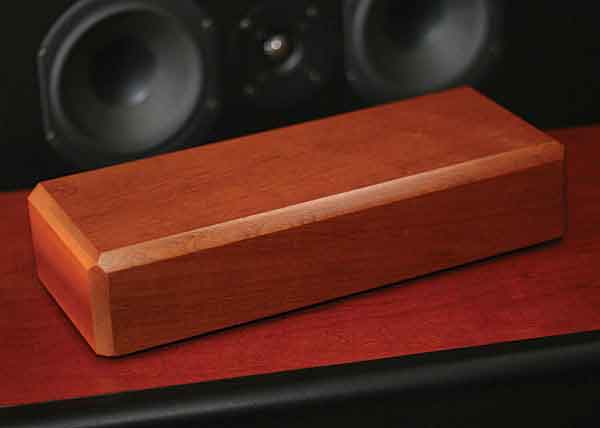 |
PTE MMMC-R: $1595 Made in the US, this MM/MC phono preamp is housed in an attractive wooden case and contains a full complement of gain and loading options selected via DIP switches. In moving-coil mode the PTE produced compact, well-focused images, an expansive soundstage, and very good macrodynamics. In moving-magnet mode, however, the PTE sounded "flat, cardboard, and glary," said MF. Changes in production to the MMMC's MM section are said to improve its sound. JA's measurements of a current production sample showed that the MMMC offers superb behavior via both its MC and MM inputs. Current production has increased power-supply voltage and uses active RIAA equalization and low-tolerance film capacitors. While the original version sounded "flat, cardboardy, and glary" in MM mode, the revised version offered "tube-like richness and warmth," said MF, hence the promotion to Class B. (Vol.34 No.10, Vol.35 Nos.2 & 6 Read Review Online) |
 |
Robyatt Audio Mono: $675 Simple inside and out, the True Mono SUT step-up transformer is made to Robyatt's specifications by AK Audio of Brooklyn, New York, and comprises just a single transformer and some bits of wire and connectors in a clean copper case. Fit and finish were rough. The True Mono SUT worked well with every mono cartridge AD had on hand and exhibited a "tremendous sense of scale and cavernously deep bass response." Also available as part of Robyatt Audio's Ultimate Mono Record Playing System ($3000), with the Miyajima laboratory Premium Mono BE phono cartridge and Tektron Italia Mono phono preamp. (Vol.35 No.6 Read Review Online) |
 |
Rogue Audio Ares: $1995 Made in the US, this beautifully built, all-tube design uses pairs of 12AX7 and 12AU7 tubes, has CineMag step-up transformers for low-output moving-coil cartridges, and provides 27 DIP switches for three levels of gain (MM/high-output MC, 0.5–1.0mV; MC, less than 0.5mV) and capacitive loading options. Matched with the Shure V15VxMR MM cartridge, the Ares produced a fully developed, harmonically rich, and three-dimensional aural picture, said MF. Through its MC input, the Ares had a fast, dynamic, slightly dark overall sound, with a slightly thin mid- and high treble. "That Rogue can offer this beauty for only $1995 makes you wonder what some of the other manufacturers are smoking," marveled Mikey. (Vol.34 No.9) |
 |
Silvercore One-to-Ten phono step-up transformer: $630 $$$ Designed and manufactured in Germany, the Silvercore One-to-Ten step-up transformer is packaged in an attractive lidded box of pulpy gray fiber and is built into a substantial case of polished stainless steel. It contains a stereo pair of toroidal transformers, wound from copper wire on proprietary amorphous cores, with a primary-coil impedance of 100 ohms. Inserted between the EMT TSD 15 pickup head and the 47k ohm phono inputs of AD's Shindo Masseto preamplifier, the One-to-Ten sounded "forceful and dramatic, yet colorful and sweet," with excellent dynamic nuances and a rich, lovely overall tone, he said. (Vol.34 No.5 Read Review Online) |
 |
Simaudio Moon 310LP: $1900 $$$ The Moon 310LP moving-magnet/moving-coil phono preamp is a fully balanced, discrete design with internal jumpers for selecting gain, resistive and capacitive loading, and equalization curves. Though its break-in time was long, the Moon 310LP offered vivid three-dimensionality, extended dynamics, precise attacks, and lengthy decays. Adding the Moon 320S outboard power supply ($1399) tightened musical events but hardened the presence region. "Simaudio's 310LP is one of the best analog values I know of," said MF. (Vol.34 No.1) |
 |
Soundsmith MCP2: $799.95 $$$ Similar in appearance to the Soundsmith MMP3, the MCP2 offers 62dB gain and continuously variable loading from 10 to 5k ohms. It had a smooth, well-balanced overall sound with a slightly warm midrange, a moderately deep soundstage, and fair bass extension. Mikey found that the MCP2's overall smoothness made long listening sessions easy, but turning the volume up too far resulted in excessive glare. Compared with the far more expensive Ypsilon VPS-100, the MCP2 exhibited a tendency toward brightness and electronic haze, said MF. (Vol.34 No.10, Vol.35 No.3) |
 |
Sutherland Engineering The Hubble: $3800 ✩ The battery-powered Hubble is a pure dual-mono design with two identical circuit boards. Like previous Sutherland designs, the Hubble uses 16 alkaline D-cell batteries instead of a mains-driven power supply. High-value storage capacitors help maintain low power-supply impedance, ensuring consistent sonic performance throughout the life of a set of batteries; Sutherland claims that one set of batteries will provide 1000 hours of service. Four options of gain and six of loading are contained on plug-in cards, while two blank cards offer user-customizable load impedances. Though it had a somewhat reticent top end and produced overdamped sustain—hence the Class B rating—the Hubble excelled at "instrumental body and textures," said MF. BD might demur, however, given his Class A rating for the less expensive Sutherland 20/20. (Vol.33 No.2) |
 |
Vad Lyd MD12 Mk.3: $2000 Made in Denmark, the extremely versatile Vad Lyd MD12 Mk.3 is "an analog archivist's dream tool," said MF. It offers single-ended inputs and outputs configurable for moving-magnet or moving-coil operation, two sets of balanced XLR outputs, equalization curves for standard LPs as well as 78rpm discs, an 80Hz low-pass filter, front-panel volume and balance controls, and a front-panel headphone jack. While the Vad Lyd allowed MF to finally play his old Edison discs, its sound lacked dynamics, detail, precision, and body. "I'd consider the Vad Lyd only if I needed the versatility," he concluded. (Vol.34 No.10) |
 |
Bellari MT502 transformer: $499 Housed in Bellari's familiar powder-coated red chassis, the MT502 step-up transformer features hand-wound coils, gold-plated inputs and outputs, two choices (9.12 and 12.4 ohms) of input impedance, and a ground lift. The MT502 produced a quiet background, sharp transients, and taut, fast, well-defined bass, said MF. A perfect match to Bellari's VP130 moving-magnet phono preamp. (Vol.33 No.11) |
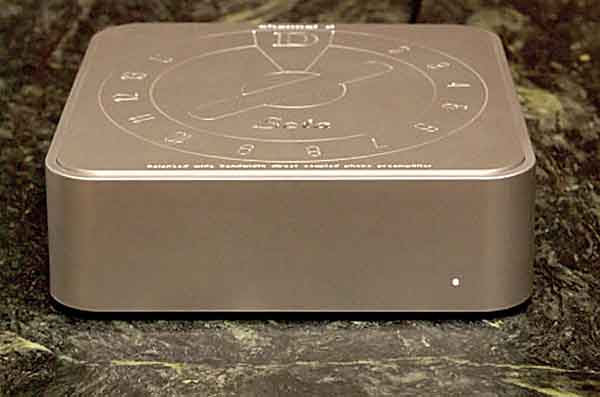 |
Channel D Seta Nano: $1599 Designed to take advantage of Pure Vinyl's digital RIAA correction, the Seta Nano includes balanced and single-ended inputs, a balanced unequalized output, a single-ended RIAA output, and a wall-wart power supply. The Nano was limited by its "somewhat metallic and slightly tinny" high frequencies, said Mikey. For use with Channel D's Pure Vinyl LP-ripping program, MF and JA preferred the Seta Model L phono preamplifier. (Vol.33 No.8 Read Review Online) |
 |
Parasound ZPhono•USB: $350 The half-width, rack-mountable Zphono•USB shares its simple, no-nonsense appearance with all of Parasound's Z models. It has two line-level inputs, a headphone jack, a rumble filter, a mono switch, a USB output for recording music to a computer, and a front-panel gain control to monitor and adjust the analog audio level. Options for moving-magnet and moving-coil loading are selected via a rear-panel switch. SM: "The Parasound Zphono•USB distinguished itself as a confident, authoritative performer with an impressively tight and certain grip on the music, and one that produced the greatest drama, scale, and sheer power I've heard in my listening room." (Vol.35 No.3 Read Review Online) |
 |
Ray Samuels Audio Emmeline F-117 The Nighthawk: $795 The Emmeline F-117 The Nighthawk is an unusually compact (4.4" W by 0.8" H by 4.25" D, 0.8 lb), battery-powered moving-magnet/moving-coil phono stage with small front-panel knobs for gain settings and loading options. Properly charged, its lithium-ion battery will play eight hours a day for nearly a week. Though not as detailed, dimensional, or dynamic as the TDL Technology 4041, the F-117's overall sound was smoother, more liquid, and somewhat more relaxed, with a warmer midrange and cleaner highs. "Its sound quality is about right for the price," decided a slightly disappointed MF. (Vol.34 No.1) |
 |
Soundsmith MMP3: $499.95 The modest MMP3 provides 43dB gain, comes in a nicely machined aluminum case, and is powered by a 24V wall wart. It produced very quiet backgrounds and reasonably good dynamics, but its bass extension and punch were only okay, its imaging was slightly diffuse, and its sound suffered overall from a slight metallic haze. "It's what you can expect for $400 (price when reviewed)," said MF. "If that's what you can afford, the MMP3 at least gets the job done quietly and cleanly." (Vol.34 No.10) |
 |
Tektron Italia Mono: $1400 Made in Italy exclusively for Robyatt Audio, the Mono Phono phono preamplifier is housed in a wood-frame box with a solid-copper top that doubles as a ground plane. The Tektron's power supply uses an onboard mains transformer with an EZ80 full-wave rectifier tube for the rail voltage and a silicon rectifier bridge for the heater voltages. Gain is supplied by a pair of 12AX7 dual-triode tubes, which share the signal path with a passive RIAA filter. Fit and finish were excellent. The sound was "workmanlike," with a slightly bright tonal balance, decent musical flow, and a nice sense of presence, said AD. Also available as part of Robyatt Audio's Ultimate Mono Record Playing System ($3000), with the Miyajima laboratory Premium Mono BE phono cartridge and Robyatt Audio True Mono SUT step-up transformer. (Vol.35 No.6 Read Review Online) |
 |
Musical Fidelity V-LPS II: $199 Identical in size (3.75" W by 1.7" H by 6.7" L) to the original model, the V-LPS II has an attractive silver case, a revised RIAA EQ circuit, and a new, discrete input stage for lower distortion and a higher signal/noise ratio. It sounded slightly soft on top and bottom, but offered good tonal color and detail, said SM. Although adding the V-PSU II power supply ($249) created a larger, more forceful overall sound, the V-LPS II nevertheless lacked the Parasound Zphono•USB's drama and impact. (Vol.35 No.5 Read Review Online) |
 |
NAD PP 3i: $199 $$$ The simple, small (5.3" W by 1.7" H by 1.6" D) PP 3i has circuitry identical to that of NAD's PP 2 phono stage, but adds a line input and a 16-bit, bus-powered A/D converter with USB interface for digitizing LPs via a Mac or PC, and includes user-friendly VinylLite software. Used as a standard phono preamp, the PP 3i was neutral, delicate, and resolving, with a rich midrange, fast transients, and strong senses of coherence, pacing, and rhythmic consistency, said BJR. Digitized files maintained the original LPs’ harmonic and dynamic signatures, but sacrificed a bit of air, richness, and warmth. "The PP 3i has no meaningful flaws," said BJR. "A superb value," agreed JA. (Vol.33 No.4 Read Review Online) |
 |
NAD PP 2i: $169 $$$ ✩ NAD improved their "pleasant-sounding" PP 1 by adding greater gain and MC compatibility, increasing parts quality with metal-film resistors and film-type capacitors, and upping the power-supply voltage from 15 to 24V. "Somewhat dry, less than generous on harmonic overtones, and lacking overall complexity and dynamic subtlety, the PP 2i still managed to get the fundamentals remarkably correct," said MF. (Vol.27 No.10; see BJR's review of the PP 3 USB in Vol.33 No.10) |
Комментариев нет:
Отправить комментарий